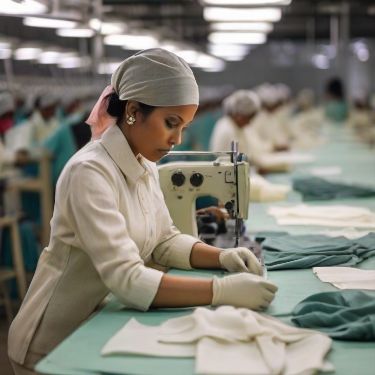Introduction
Dress manufacturing is the process of making dresses, from design to final product. It includes choosing fabrics, cutting, stitching, and quality checking to ensure the best results.
Our manufacturing process is well-organized and focused on quality. We use good materials, skilled workers, and modern machines to create stylish and comfortable dresses. From fabric selection to packaging, we make sure every step is done carefully. Here’s how our manufacturing works.
Table of Contents
(A).What is the dress manufacturing
Dress manufacturing is the process of designing, producing, and distributing dresses on a small or large scale. It involves several steps, including fabric selection, cutting, stitching, finishing, and packaging. This industry serves various markets, from casual wear and formal dresses to designer and custom-made outfits.
1.Mass Production
Large-scale manufacturing for retail brands and fashion chains.
2.Custom Manufacturing
Small-scale, personalized dress-making for boutiques or high-end clients.
3.Private Label Production
Companies produce dresses under another brand’s name.
(B).How is our dress manufacturing
Dress manufacturing is a multi step process that involves designing, fabric selection, cutting, stitching, finishing, and quality control. Here’s a breakdown of how it works.
1.Making cloth for dresses
Cloth for dresses is made from natural fibers like cotton, silk, and wool or synthetic fibers like polyester and nylon. First, fibers are spun into yarn, which is then woven or knitted into fabric. The fabric is dyed, printed, or treated for softness and durability. After quality checks, it is sent to manufacturers to be cut and stitched into dresses.
2.Desing & Planning In Dress Manufacturing
Research fashion trends, customer demands, and market needs.Create sketches or digital designs.Select fabric, colors, and trims.Develop a tech pack (detailed design specifications).
3.Pattern Making In Dress Manufacturing
Pattern making is the process of creating a template for cutting fabric pieces to sew a dress. It starts with a design sketch, which is converted into a pattern using paper or computer software (CAD). The pattern includes different parts of the dress, like the front, back, sleeves, and collar, with exact measurements. Patterns are tested by making a sample garment, and adjustments are made if needed. Once finalized, the pattern is used to cut fabric in bulk for stitching and production.
4.Fabric Sourcing In Dress Manufacturing
Fabric sourcing is the process of finding and selecting the right materials for making dresses. It involves choosing fabrics based on quality, texture, color, durability, and cost. Manufacturers buy fabrics from textile mills, wholesalers, or local markets. Factors like fabric type (cotton, silk, polyester, etc.), weave, stretchability, and sustainability are considered. Once the fabric is selected, samples are tested for shrinkage, colorfastness, and comfort before bulk purchasing. Good fabric sourcing ensures high-quality dresses and smooth production.
5.Fabric cutting In Dress Manufacturing
Fabric cutting is the process of cutting fabric into pieces based on the dress pattern. First, the fabric is laid flat or stacked in layers to ensure precise cutting. Then, using tools like scissors, cutting machines, or laser cutters, the fabric is cut according to the pattern shapes. Accuracy is important to avoid fabric wastage and ensure a perfect fit. Once cut, the fabric pieces are labeled and sent for stitching.
6.Stitching In Dress Manufacturing
Stitching is the process of sewing fabric pieces together to form a dress. Skilled workers use industrial sewing machines to join the cut fabric using different stitching techniques like straight stitch, overlock, and zigzag stitch. Each part, such as sleeves, collars, and hems, is stitched carefully to ensure durability and a neat finish. After stitching, the dresses are checked for any defects before moving to the finishing stage.
7.Quality Control In Dress Manufacturing
Quality control ensures that dresses meet the required standards before they reach customers. It involves checking fabric quality, stitching strength, size accuracy, and overall finishing. Inspectors look for defects like loose threads, uneven stitching, or fabric flaws. Tests for colorfastness, shrinkage, and durability are also conducted. If any defects are found, the dresses are repaired or rejected. This process helps maintain high-quality products and customer satisfaction.
8.Finishing In Dress Manufacturing
Finishing is the final stage where dresses are prepared for sale. It includes ironing or steaming to remove wrinkles, trimming loose threads, adding final details like buttons or embroidery, and checking overall appearance. Dresses are also labeled with size, brand, and care instructions. Once finished, they are folded, packed, and sent for distribution. Proper finishing enhances the look and quality of the dress.
9.Packaging In Dress Manufacturing
Packaging is the process of preparing finished dresses for storage, transport, and sale. Dresses are folded neatly and placed in protective covers or boxes. Labels, tags, and barcodes with brand details, size, and care instructions are attached. Packaging protects dresses from dust, damage, and wrinkles. Depending on the brand and market, eco-friendly or luxury packaging may be used. Well-packaged dresses look more appealing and ensure safe delivery to customers or stores.
10.Distribution
Distribution is the process of delivering finished dresses to retailers, wholesalers, or customers. After packaging, the dresses are sorted based on size, color, and order details. They are then transported through delivery services, warehouses, or direct shipping to stores and online buyers. Efficient distribution ensures that dresses reach the market on time, maintaining customer satisfaction and sales flow.
Conclusion
Dress manufacturing is the process of making dresses, from designing to stitching and finishing. Good manufacturing ensures quality, comfort, and style.In our manufacturing, we focus on using the best materials, skilled stitching, and careful quality checks. This helps us create well made dresses that look good and last long.

Waseem Kolappuram
A content writer is a professional who creates engaging and informative written material for various platforms, including websites, blogs, and social media. They conduct thorough research to ensure accuracy and relevance in their content. By incorporating SEO strategies, they enhance content visibility and drive organic traffic. Content writers adapt their tone and style to align with the brand’s voice and target audience. They collaborate with marketing teams to develop content strategies that support business objectives. Their work includes drafting, editing, and proofreading to maintain high-quality standards. Effective content writers stay updated on industry trends to produce timely and relevant content. They play a crucial role in building brand awareness and engaging customers. Strong writing skills, creativity, and attention to detail are essential in this role. In today’s digital landscape, content writers are vital in conveying a brand’s message and values.

